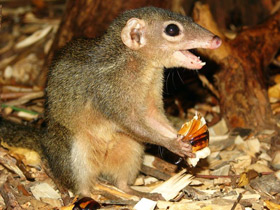The treeshrews (also called tree shrews or banxrings)
The treeshrews (also called tree shrews or banxrings) are small mammals native to the tropical forests of South and Southeast Asia. They make up the entire order Scandentia, which split into two families: the Tupaiidae (19 species, "ordinary" treeshrews), and the Ptilocercidae (one species, the pen-tailed treeshrew).
Though called 'treeshrews', and despite having previously been classified in Insectivora, they are not true shrews, and not all species live in trees. They are omnivores; among other things, treeshrews eat fruit.
Treeshrews have a higher brain to body mass ratio than any other mammal, including humans, but high ratios are not uncommon for animals weighing less than 1 kg (2 lb).
Among orders of mammals, treeshrews are closely related to primates, and have been used as an alternative to primates in experimental studies of myopia, psychosocial stress, and hepatitis.
Name
The name Tupaia is derived from tupai, the Malay word for squirrel, and was provided by Sir Stamford Raffles.
Scandentia are squirrel-like small mammals distributed in the tropical forests of southern and south-eastern Asia. Interestingly, both are referred to by the same Malay word "tupai", from which the genus Tupaia derives its name. At first these animals were attributed to insectivores, then for 50 years they were considered primates, but research in recent years has proved their isolation, and now they are recognised as the only representatives of the order Scandentia. Most of them live in Borneo (10 out of 18 known species). Among them there are semi-arthropods and semi-terrestrial, diurnal and crepuscular, herbivorous and insectivorous. Compared to primates, Scandentia have a fairly primitive build and, scientists believe, are close to the earliest primate ancestors in appearance and lifestyle. Unlike modern primates, Scandentia have claws (rather than nails) on their fingers, their thumb is not opposable to the others, their snout is strongly extended forward, and their eyes are located on the sides of their head. The teeth of Scandentia are very numerous, sharp, small, almost identical and very similar to those of insectivores.
Taxonomy
They make up the entire order Scandentia, split into the families Tupaiidae, the treeshrews, and Ptilocercidae, the pen-tailed treeshrew. The 20 species are placed in five genera.
Treeshrews were moved from the order Insectivora into the order Primates because of certain internal similarities to primates (for example, similarities in the brain anatomy, highlighted by Sir Wilfrid Le Gros Clark), and classified as a "primitive prosimian", however they were soon split from the primates and moved into their own clade. Taxonomists continue to refine the treeshrews' relations to primates and to other closely related clades.
Molecular phylogenetic studies have suggested that the treeshrews should be given the same rank (order) as the primates and, with the primates and the flying lemurs (colugos), belong to the grandorder Euarchonta. According to this classification, the Euarchonta are sister to the Glires (lagomorphs and rodents), and the two groups are combined into the superorder Euarchontoglires. However, the alternative placement of treeshrews as sister to both Glires and Primatomorpha cannot be ruled out. Recent studies place Scandentia as sister of the Glires, which would invalidate Euarchonta: It is this organization that is shown in the tree diagram below.
Order Scandentia
The 23 species are placed in four genera, which are divided into two families. The majority are in the "ordinary" treeshrew family, Tupaiidae, but one species, the pen-tailed treeshrew, is different enough to warrant placement in its own family, Ptilocercidae; the two families are thought to have separated 60 million years ago. The former Tupaiidae genus Urogale was disbanded in 2011 when the Mindanao treeshrew was moved to Tupaia based on a molecular phylogeny.
Family Tupaiidae
- Genus Anathana:
- Madras treeshrew, Anathana ellioti;
- Genus Dendrogale:
- Bornean smooth-tailed treeshrew, Dendrogale melanura;
- Northern smooth-tailed treeshrew, Dendrogale murina;
- Genus Tupaia:
- Northern treeshrew, Tupaia belangeri;
- Golden-bellied treeshrew, Tupaia chrysogaster;
- Bangka Island treeshrew, Tupaia discolor;
- Striped treeshrew, Tupaia dorsalis;
- Mindanao treeshrew, Tupaia everetti;
- Sumatran treeshrew, Tupaia ferruginea;
- Common treeshrew, Tupaia glis;
- Slender treeshrew, Tupaia gracilis;
- Javan treeshrew, Tupaia hypochrysa;
- Horsfield's treeshrew, Tupaia javanica;
- Long-footed treeshrew, Tupaia longipes;
- Pygmy treeshrew, Tupaia minor;
- Mountain treeshrew, Tupaia montana;
- Nicobar treeshrew, Tupaia nicobarica;
- Palawan treeshrew, Tupaia Palawanensis;
- Painted treeshrew, Tupaia picta;
- Kalimantan treeshrew, Tupaia salatana;
- Ruddy treeshrew, Tupaia splendidula;
- Large treeshrew, Tupaia tana.
Family Ptilocercidae
- Genus Ptilocercus:
- Pen-tailed treeshrew, Ptilocercus Lowii.

















































